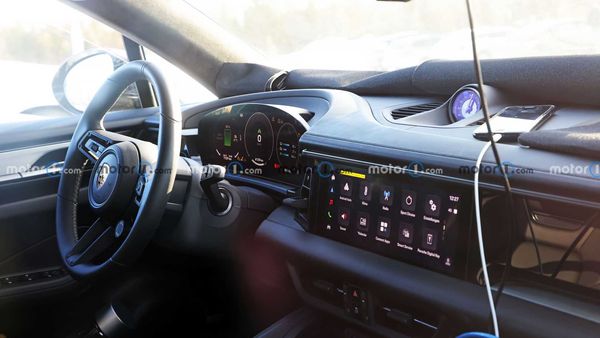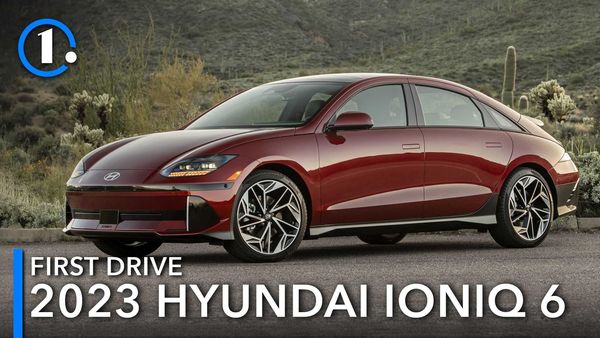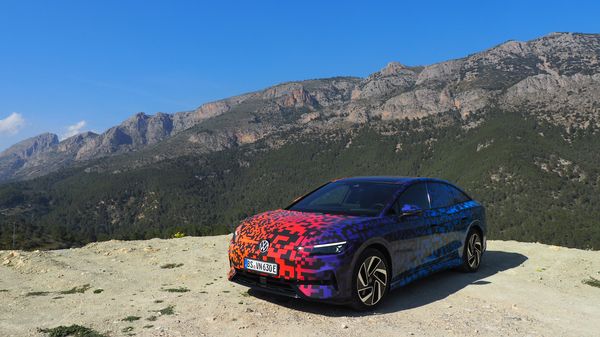
I’m one of just six journalists from American outlets invited to this rather remote location near the Mediterranean coast of Spain, between Valencia and Alicante. Volkswagen has gone to an awful lot of logistical effort – complicated flight plans, multiple hotels, on-site experts, and workshops – for me to get behind the wheel of an unfinished prototype and drive about 45 minutes through the mountains.
The reason for the fuss is the upcoming (though still far-off) Volkswagen ID.7 sedan, a new flagship for the company’s electrification efforts. Although my drive notes will be littered with caveats – the vehicles on hand were far from production form. If you’re interested in getting the fuller story, I encourage you to check back on April 17 when we’ll be allowed to share a lot more information and photos of the uncovered car.
In the meantime, this amuse-bouche confirms Volkswagen is entering new territory with this near-luxury EV.
The verdict issued here is a loose estimate based on information that's subject to change. It will likely evolve as more information about the ID.7 becomes available and we get more opportunities to test the new EV. A vehicle's ratings are relative only to its own segment and not the new-vehicle market as a whole. For more on how Motor1.com rates cars, click here.
| Quick Stats | 2025 Volkswagen ID.7 RWD Prototype |
| Motors: | Permanent Magnet Motor |
| Output: | 282 Horsepower / 402 Pound-Feet |
| Battery: | 82.0-Kilowatt-Hour Lithium-Ion (77.0 kWH Usable) |
| EV Range: | 300 Miles (est. on WLTP figures) |
| Base Price: | $38,000 (est.) |
Gallery: 2025 Volkswagen ID.7 Prototype: First Drive







More Bang Than Buzz
The ID.7 shares VW’s modular electric drive platform with the rest of the ID family (that’s ID.4 and ID. Buzz here in the US) and the familiar 86.0-kilowatt-hour (77.0 kWh useable) with a 400-volt architecture. Drivers in other markets will be able to option a 91.0-kWh battery (86.0-kWh gross) that sadly won’t be coming to our shores.
Thanks in large measure to the sedan’s slippery 0.23 coefficient of drag (which matches Tesla’s Model 3, for instance), expect the smaller-battery ID.7 to get usefully more range than the max of 275 miles offered by the ID.4. That said, it’s fair to say that we won’t have anything like official EPA range or efficiency figures for quite a while, considering the car won’t go on sale in the US until the second half of 2024.


I drove the single-motor, rear-drive variant of the ID.7, and I can report that the new electric motor is a welcome addition to the company’s portfolio. Producing 282 horsepower and 402 pound-feet of torque, with stronger permanent magnets in the rotor and a revised stator, ID.7 puts power to pavement seamlessly. Acceleration felt quite good as I caught up and occasionally passed slow-moving traffic on our mountain roads-only drive route, but it’ll take a more extensive test to feel the effects on high-speed US highways.
Four drive modes govern how the ID.7 goes down the road, as part of a more extensive “Driving Dynamics Manager” suite of software. Here I have to caution that my impressions might not hold up to the production version of the car, as the system wasn’t fully baked in the prototype.
Grade: Incomplete
For me, there wasn’t a tremendous difference in steering or suspension response as I toggled between the available Comfort, Sport, Eco, and Individual modes, try as I might to suss them out. Sport mode did offer a noticeably more potent accelerator, as you’d expect, and seemed to increase the braking effect from motor regeneration. VW experts on site weren’t able to confirm or deny that enhanced regen was part of the Sport programming, speculating instead that I may have been feeling GPS-enabled predictive deceleration while heading down a steep and winding road.
I’m not exactly sure how to square the best guess from the VW team with my experience, to be honest. Yet again, we’ll need more seat time in a production-ready car to get some answers.


I can confirm that there isn’t anything like a one-pedal driving mode for the ID.7. Volkswagen, like portfolio partner Porsche, has adopted the coasting-over-regen approach to efficiency, which is probably correct. However, for someone like me that appreciates using a one-pedal style in city driving, the lack of any configurability here is a head scratcher.
ID.7’s super aerodynamic shape had a tremendous effect on in-cabin experience, as the car was whisper quiet on the road. Again, this was on two-lane roads at speeds that rarely approached 70 miles per hour, so the test isn’t complete. But the promise is certainly evident for top-level NVH.
The hushed environment will be somewhat filled with simulated audio that wasn’t active on my car, as well. It doesn’t seem like you can turn those noises off but you can at least configure them in Individual mode to reflect your favorite – here’s hoping it’s compelling audio.

Overall ride quality seems to underline Volkswagen’s positioning of this car as an executive experience. Over a few sections of bad pavement, loose gravel, and speed bumps in a village, the ride was extremely well damped and free of impact harshness of any kind. Tuning for the adaptive damping system, in every mode I tried, seemed biased towards comfort and high-speed stability more than sporty response.
Steering tune was about the same: The variable ratio electric rack wants nothing more than to guide you smoothly around gentle curves. Feedback is absolutely minimal, turn-in is tepid, and weighting is pleasantly middle of the road. VW calls the ride experience “the electric business class” so the relaxed steering and handling hit the presumed target here.

Tech Laden
As you read this, Volkswagen is still insisting that media invited to experience the prototype ID.7 hold back on many of the most interesting advancements in terms of in-cabin technology. What follows, then, is a list of features with very little real-world analysis, as I promised to save that for later.
With that said, I will yet again encourage you to revisit this first drive on April 17 as we will update this section with a lot more detail.

What can I say? Let me start here: Because everyone who drove an ID.4 asked, the sliders to control media volume and climate control temp are now backlit as god intended. No more random stabbing at the IP on a dark drive home. What’s more, there are fixed controls for the heated and cooled seats and a button for the heated steering wheel on, you guessed it, the steering wheel.
A 15.0-inch screen commands the center console of the car, and is running a wholly new software setup that, you guessed it, I can’t tell you about right now.

More revolutionary than that large screen (almost every new EV has a very large screen these days, after all) is the small one found where you’d expect to have an instrument cluster in front of the driver. In an effort to keep a driver’s eyes on the road, most all information you’d expect to find in a gauge cluster has been moved to a heads up display. Again, I can’t say much about how the system works or what it looks like. What I can tell you is that, like just about every other HUD I’ve ever used, the ID.7 affair was all but invisible on a sunny day in Spain while I had my polarized sunglasses on.

Space For Days
It remains to be seen how this global flagship sedan will hit with SUV-obsessed American buyers, but they won’t have much of an argument to make if space is a primary concern. The ID.7 measures a generous 195.3 inches long on a 116.8-inch wheelbase, and stretches 73.3 inches wide.
For passengers, that nets out to a voluminous five-seater cabin. InsideEVs readers might remember that I’m the biggest car tester on staff at 6-foot-5 and 240 pounds, and I had acres of space sitting in the back behind my own driving position.
In terms of cargo, VW specifies 18.7 cubic-feet in the luggage compartment, the eye test says you’re going to be able stuff a lot under this long liftback. With rear seats that fold nearly flat, one is immediately reminded of the cargo area of cars like the Audi A7 and even the European Passat wagon. (I immediately thought of my old Saab 9-5 Aero that I once used to transport all of my Earthly goods, including a twin mattress, but I’m old…).
Obviously this prototype drive wasn’t a complete experience, but the vibe is one of a level-up for the ID series of EVs. Certainly if wild speculations of price (just south of $40,000 seems to be in play) are even close to accurate, the combination of range, performance, tech, and utility could be compelling for many EV shoppers.










